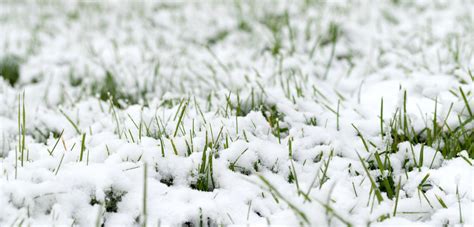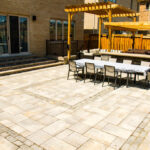You may be wondering what happens to grass in the winter. Why does your grass turn brown? When does grass stop growing? Does it actually die each winter?
In this new blog post, we’ll discuss what happens to grass in the winter, help you prevent common winter lawn problems, and give you tips on winter lawn care.
With the right preparation, you can enjoy a lush, verdant lawn in the spring.ç
Does Grass Grow in the Winter?
Depending on your location, grass can still grow in the winter, but you’ll probably notice that it doesn’t happen as quickly as it did in the warmer months.
Less sunlight and colder temperatures may slow down lawn growth, but it often continues nonetheless.
However, if the weather gets cold enough, your grass will stop growing and will enter a state known as dormancy.
When does grass stop growing?
This usually happens when temperatures drop below 40 degrees Fahrenheit.
So, if you live in a region with moderate or severe winters, chances are your grass will stop growing.
How Does Grass Change in the Winter?
You’ve surely noticed that grass changes in the winter. It usually loses its green color and turns pale or brown.
After the snow melts in the spring, you may have an entire carpet of brown around your house.
What causes this? In other words, what happens to grass in the winter?
As we mentioned above, cold weather triggers grass to go dormant.
This is a completely normal process during which your grass stops growing in order to conserve energy and water.
Dormancy also helps grass survive extreme temperatures. If you live in an area that gets a lot of wind in the winter, the wind can strip your grass blades of moisture.
Related article: What Is the Best Low Maintenance Grass for Minneapolis?
When the soil freezes, the grassroots can’t take up more moisture to replace what was lost, and the blades turn brown.
Likewise, if you get a blanket of snow each year, the snow blocks the sunlight from your grass, causing it to lose color.
Not to worry. Your grass isn’t dead, though it might look like it.
When temperatures begin to warm in March and April, your grass will shake off its dormancy.
Assuming you performed good winter lawn care, your grass should revive and begin renewing its healthy green coloring.
Common Winter Lawn Problems
Cold weather makes your lawn more vulnerable to diseases, which is why certain lawn problems tend to pop up in early spring.
Here are 3 major winter lawn problems to look out for when winter ends.
Snow Mold
If you notice yellow, pink, or gray patches on your lawn after the snow melts, you may have a case of snow mold.
This condition is caused by a type of fungus that lives in your soil throughout the year.
However, the combination of warming temperatures and moist soil from snowmelt can trigger the fungus to grow.
Snow mold comes in two types: gray snow mold and pink snow mold. The pink version is more severe and can kill grass shoots and roots.
Red Thread
Have you noticed strange strands of red in your grass? It may look a bit like fishing wire, but it’s actually a fungal infection.
Red thread can show up in patches — or, in a worst-case scenario — take over your entire lawn.
It tends to appear in both the spring and fall seasons and begins with small, reddish-pink threads that grow on the tips of grass blades.
Red thread can discolor your grass and cause it to become weak and thin.
Related article: Lawn Restoration in Otsego MN: 7 Steps for a Beautiful Restoration
Large Patch
In the spring, a large patch will show itself as big circles of thin, damaged grass with brown or bronze rings on the outer edge of the circle.
The disease affects warm-season grasses and is caused by a strain of fungus.
The fungal disease usually takes hold in the fall but becomes most noticeable in the spring once the infection has grown.
Patches can be just a few inches to several feet wide.
How to Perform Winter Lawn Care
The aforementioned winter lawn diseases are caused by strains of fungus. It is difficult to address these issues once they have already attacked your lawn.
The best way to deal with a fungal infection in your lawn is to prevent one from occurring in the first place.
The good news is that the remedy for all three problems is the same. Perform good winter lawn care.
A healthy lawn will better resist fungal infections.
It’s difficult to work on your lawn in the dead of winter. The soil might be frozen, and your grass could be hiding under inches of snow.
That’s why you should focus most of your winterization efforts in the fall. It’s best to begin your winter lawn care in September or October.
Here’s what you should do to keep your lawn healthy in the winter.
Overseed and Repair Bare Spots
Locate brown or bare spots in your lawn and repair them.
Depending on how large the bare spots are, you will need to plant new sod or heavily seed the affected area.
Make sure the sod or seed you use is specifically formulated for your climate and type of lawn.
If your lawn is thin in spots, overseeding it in the fall months can help build it back up before winter sets in.
Remove Thatch and Aerate
While a thin layer of thatch is good, anything thicker than half an inch can obstruct the movement of water and nutrients, which can lead to diseased grass.
A thicker thatch is also an ideal habitat for insects. To prevent this from happening, you’ll need to remove any excess thatch and aerate the soil beneath it.
Dethatching tools and core aerators are necessary to complete this task. If you don’t own these tools, they can be rented from most home improvement stores.
By dethatching and aerating your lawn in the fall, you’ll improve its overall health and well-being.
Related Topic: Protect Your Lawn From Frost Damage
Change Watering Schedule
Depending on what part of the country you live in, your grass will continue to grow through the fall months until the first hard freeze, frost, or snow.
It’s important to keep watering your lawn during this time as needed to keep it healthy.
If you live in a part of the country that gets heavy rainfall during autumn, you’ll need to adjust your watering schedule so your lawn doesn’t become oversaturated and washed out.
Weed and Feed
Choosing a good fall lawn fertilizer is essential to fall lawn care.
Since weeds are hardy and will continue to grow until the first heavy freeze of the season, choose an effective weed and feed fall lawn fertilizer to eliminate late-season weeds.
The right fertilizer can also help your lawn develop and rebuild roots that may have been damaged by the heat and dryness of the summer months.
Remove Fallen Leaves
No fall lawn care is complete without getting rid of the leaves that have fallen into your yard.
Despite what you might have heard, a layer of leaves isn’t beneficial to your yard.
It may seem like the leaves form a blanket for your lawn and prevent it from freezing during the winter, but that isn’t how it works.
A heavy layer of leaves can actually suffocate your grass by not allowing it to breathe.
Furthermore, if the fallen leaves are waxy or have a high acidity rate, they can throw off the pH balance of your grass and cause even more damage.
To prevent this from happening, clean the leaves out of your yard.
You can do this by raking them up or by mowing them into tiny bits so they fall into your lawn’s canopy and are absorbed back into the soil.
Keep a Healthy Lawn During the Winter
Now you know what happens to grass in the winter.
You also know that taking action in the fall can set your lawn up for success through the winter and into spring.
However, with everything you’ve got going on during the fall, the time-consuming work of preparing your lawn for the winter is difficult.
Lawn care takes up a lot of your time, no matter what time of year it is.
For a beautiful lawn without all the work and stress, let Magic Construction Minnesota help you out.
We perform ongoing lawn maintenance, seasonal services, and one-off projects.
Our local teams are happy to provide you with a free estimate based on your personalized needs and budget.
Magic Construction Minnesota will make sure your lawn is ready for the winter and ensure it stays healthy throughout the year.
Contact us today!






